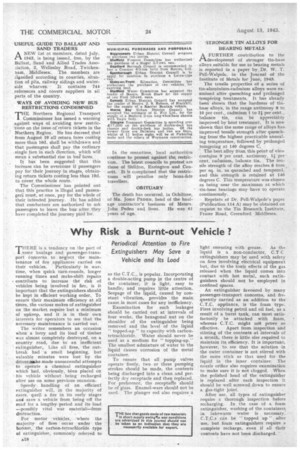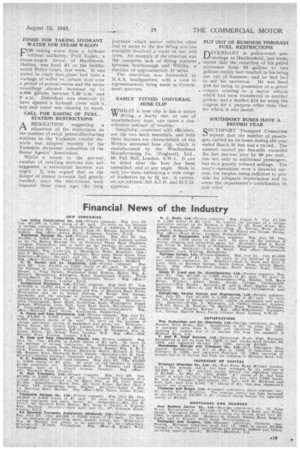Why Risk a Burnt-out 'Vehicle ?
Page 20

Page 21

If you've noticed an error in this article please click here to report it so we can fix it.
Periodical Attention to Fire Extinguishers May Save a Vehicle and Its Load THERE is a tendency on the part of 1 some haulage and passenger-transport concerns to neglect the maintenance of fire appliances carried on their vehicles. Particularly in wartime, when quick turn-rounds, longer running times and make-shift repairs contribute to increase the risk of vehicles being involved in fire, is it important that the extinguishers should be kept in efficient working order.. To ensure their maximum efficiency at all times, the various makes of extinguisher on the market require but a minimum of upkeep; and it is in their own interests for operators to see that the necessary maintenance is carried out.
The writer remembers an occasion when a lorry and its load of timber was almost completely destroyed, on a country road, due to an inefficient extinguisher. Like all fires, the outbreak had a small beginning, but valuable minutes were lost by the driver Mahe made unsuccessful attempts to operate a chemical extinguisher which had, obviously, been placed on his vehicle without being recharged after use on some previous occasion:
Speedy . handling of an efficient extinguisher will, in the majority of cases, quell a fire in its 'early stages an save a vehicle from being off the road for a lengthy period and its load —possibly vital war material—from destruction.
For motor vehicles, . where the majority of fires occur under the bonnet, the carbon-tetrachloride type of extinguisher, commonly referred to as the C.T.C,, is popular. Incorporating a double-acting pump in the centre of the container, it is light, easy to handle,. and requires little attention. Seepage of the liquid, caused by constant vibration, provides the main cause in most cases for any inefficiency.
Examination for such leakages should be carried out at intervals of four weeks, the hexagonal nut on the shoulder of the extinguisher being removed and the level of the liquid " topped-up " to capacity with carbontetrachloride. Water should never be used as a medium for " togging-up." The smallest admixture of water to the liquid causes corrosion of the metal container.
To ensure that all pump valves operate freely, two or three pumping strokes should be made, the contents being discharged into a clean and perfectly dry receptacle and the replaced. For preference, the receptaige should be of glass. Enamel-ware should not be used. The plunger rod also requires a light smearing with grease. As the liquid is a non-conductor, CT C extinguishers may be used with safety on fires involving electrical equipment but, due to the toxic effects of the gas released when the liquid comes into contact with hot metal,, such extinguishers should not be employed in confined spaces.
An extinguisher favoured by many passenger-transport concerns, and frequently carried as an addition to the C.T.C. appliance, is the foam type. Fires involving petrol and oil fuel, as a result of a burst tank, can most-satisfactorily be attacked with foam, whereas C.T.C. might not prove so effective. Apart from inspection and stirring of the contents at intervals of a month, there is little .else required to maintain its efficiency. It is important, however, to. see that the solution in the outer container is not stirred with the same stick as that used for the liquid in the inner container. The nozzle orifice also requires examination to make sure it is not clogged. When the polished head of the extinguisher is replaced after each inspection it should be well screwed down to ensure a gas-tight joint.
After use, all types of extinguisher require a thorough inspection before recharging. In the case of a foam extinguisher, washing of the containers in lukewarm water is necessary. C.T.C.s can be "-topped up" after use, but foam extinguishers require a complete recharge, even if all their contents have•not been discharged.
FINED FOR TAKING HYDRANT WATER FOR STEAM WAGON COR taking water from a hydrant without authority, Fred Tasker, a steam-wagon driver, of Boothtown, Halifax, was fined £1 at the Saddleworth Police Court, last week: It was stated in court that .there had been a wastage of water on certain days over a period of several:weeks and the meter recordings ,showed increases up to 4,000 gillons between 7.30 a.m. and 8 a.m. Defendant was observed to have opened a hydrant cover with a key and water was running to waste.
CALL FOR EASING OF FUELSTATION RESTRICTIONS ARESOLUTION suggesting a relaxation of the restrictions on the number of retail petrol-cIrstributing stations in the Yorkshire coastal districts was adopted recently by the Yorkshire divisional coininittee of the Motor Agents Association.
Whilst a return to the pre-war number of retailing stations was not . .suggested, a substantial increase was urged. It was argued that as the danger of enemy invasion had greatly • receded, since the restrictions were imposed three years ago, ' the long journeys which motor vehicles often _had to make to the few filling stations available involved a waste of fuel andtyres. An example of the situation was the complete lack of filling stations between Scarborough and Whitby, a distance of approximately 21 'miles. • The resolution was forwarded to M.A.A. headquarters, with a view to representations being made in Govern-. ment quarters.
EASILY FITTED UNIVERSAL HOSE CLIP
WHILST a hose clip is but a minor fitting, a faulty one, or one of unsatisfactory type, can cause a considerable aniount of trouble.
Simplicity, combined with efficiency, are the two main essentials, and both these features are characteristic of the Wethco universal hose clip, which is manufactured by the Weatherhead Manufacturing Co. (England), Ltd., 50, Pall Mall, London, S.W.1. It can be fitted after the hose has been assembled, and at any angle. Made in only two sizes, embracing a wide range of diameters up to 21 ins., it carries, we are advised, full A.I.D. and D.T.D.
approval. . PUT OUT OF BUSINESS THROUGH FUEL RESTRICTIONS
DEFENDANT in police-court proceedings at Huddersfield, last week, stated that the reduction of his petrol allowance from 20 gallons to two gallons weekly had resulted in his being put out of 'business, and he had had to sell' his motorvan. He was fined g10 for being in possession of a petrol coupon relating to a motor vehicle which had been transferred to another person, and a further £10 for using the coupon for a purpose other than that for which it was issued.
SOUTHPORT BUSES HAVE A . RECORD YEAR
SOUTHPORT Transport Committee reports that the number of passengers carried on its buses during the year ended March 31 last was a record. The number carried per bus-mile exceeded the last pre-war year by 69 per cent., due not only to additional passengers, but to a greatly reduced mileage. The year's operations were a financial success, the surplus being sufficient to provide for adequate depreeiation and to cover the department's contribution to rate relief




















































